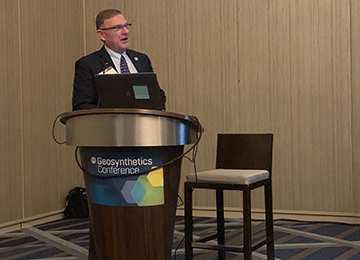Bob, a Chief Engineer with ECS with more than 30 years of experience, recently presented his paper “Design and Repair of a Reinforced Steep Slope, Pinnacle Shopping Center at Tutwiler, Birmingham, AL” at the GeoSynthetics 2019 Conference. He will also be presenting this project in March at Geo-Congress 2019. We chatted with Bob to learn more about the project and his experience with steep slope design, see what he had to say below.
Can you give a bird’s eye view of your research?
A project in Alabama had a 3,000 foot long mechanically stabilized earth slope designed by another party and during construction slope started to fail and moved laterally four feet. The wall was supporting the main entrance road of the shopping center and the fire force main, so if that broke, then the shopping center was out of business. It was critical to keep the slope from moving. The designer of the wall tried to fix it twice unsuccessfully, so the client brought in ECS to figure out how to stop the slope from moving. ECS designed a way to pin the slope and stabilize it.
What was unique about this project?
Normally as geotechnical engineers, we’re involved in figuring out a concept to fix an unstable slope and then we turn it over to a specialty foundation repair contractor to do the actual design. What’s unique for this project is that we actually did the design for the fix and provided it to the specialty contractor to install. It is very unusual for the consultant to do the detailed design for the repair.
It turns out you have presented at GeoSynthetics before, can you share more about that?
I first presented at the conference back in 1991 after winning an Engineering Excellence Honor Award from the Florida Institute of Consulting Engineers, for the “Raleigh Street Embankment”, a reinforced steep slope. I designed several steep geogrid reinforced slopes in the late 1980s including the 55-foot tall Typhoon Lagoon embankment at Walt Disney World and the 40-foot high Raleigh Street Embankment.
So you’ve been doing this kind of work since the late 1980s, what’s changed?
In the late 1980s there wasn’t any good design software and most geotechnical engineers didn’t know how to design with geogrid or geosynthetics (fabric). I actually had to teach a course on how to design a reinforced slope so a local competitor could review and approve a design for the City of Orlando.
In the late 1980s, only a few professors and high-end consultants performed this type of work, now it has gone mainstream and become a specialty focus, with many small firms that only provide services related to geosynthetic design and repair.
How did you become interested in this type of work?
I was reading Civil Engineering magazine and had a project that I thought was perfect for geogrid, so I called the main manufacturer of geogrid to get their technical assistance. They did a trial design for the steep slope and I checked the global stability and it wasn’t right, so I communicated with the manufacturer again, they revised their initial design and it still didn’t work from a stability standpoint. At this point, they sent me the program they used internally to design and I taught myself. I designed the steep geogrid reinforced slopes and everything.
The project that geogrid was perfect for it? Typhoon Lagoon Embankment at Walt Disney World. I saw the opportunity, found an application and had the guts to try something new and unproven. Lately, I have focused more on the forensic side and serve as an expert assisting owners with slopes that are not performing well.
Thanks Bob for sharing your expertise with us. If you want to learn more about stabilizing soils with geosynthetic materials, mechanically stabilized earth slope or steep slope design, contact us today.

